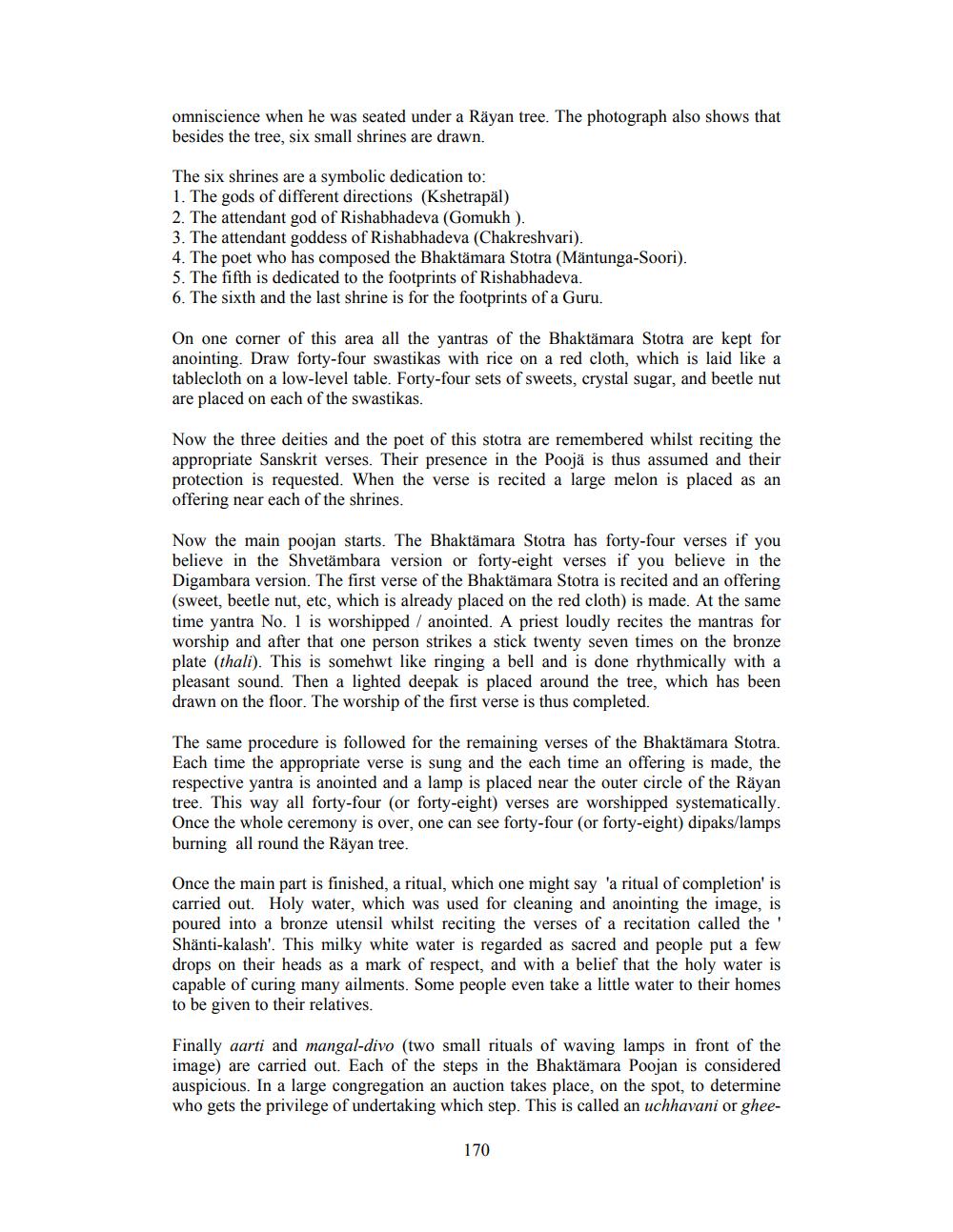________________
omniscience when he was seated under a Räyan tree. The photograph also shows that besides the tree, six small shrines are drawn.
The six shrines are a symbolic dedication to:
1. The gods of different directions (Kshetrapal)
2. The attendant god of Rishabhadeva (Gomukh ).
3. The attendant goddess of Rishabhadeva (Chakreshvari).
4. The poet who has composed the Bhaktämara Stotra (Mäntunga-Soori).
5. The fifth is dedicated to the footprints of Rishabhadeva.
6. The sixth and the last shrine is for the footprints of a Guru.
On one corner of this area all the yantras of the Bhaktämara Stotra are kept for anointing. Draw forty-four swastikas with rice on a red cloth, which is laid like a tablecloth on a low-level table. Forty-four sets of sweets, crystal sugar, and beetle nut are placed on each of the swastikas.
Now the three deities and the poet of this stotra are remembered whilst reciting the appropriate Sanskrit verses. Their presence in the Pooja is thus assumed and their protection is requested. When the verse is recited a large melon is placed as an offering near each of the shrines.
Now the main poojan starts. The Bhaktämara Stotra has forty-four verses if you believe in the Shvetämbara version or forty-eight verses if you believe in the Digambara version. The first verse of the Bhaktämara Stotra is recited and an offering (sweet, beetle nut, etc, which is already placed on the red cloth) is made. At the same time yantra No. 1 is worshipped/ anointed. A priest loudly recites the mantras for worship and after that one person strikes a stick twenty seven times on the bronze plate (thali). This is somehwt like ringing a bell and is done rhythmically with a pleasant sound. Then a lighted deepak is placed around the tree, which has been drawn on the floor. The worship of the first verse is thus completed.
The same procedure is followed for the remaining verses of the Bhaktämara Stotra. Each time the appropriate verse is sung and the each time an offering is made, the respective yantra is anointed and a lamp is placed near the outer circle of the Rayan tree. This way all forty-four (or forty-eight) verses are worshipped systematically. Once the whole ceremony is over, one can see forty-four (or forty-eight) dipaks/lamps burning all round the Räyan tree.
Once the main part is finished, a ritual, which one might say 'a ritual of completion' is carried out. Holy water, which was used for cleaning and anointing the image, is poured into a bronze utensil whilst reciting the verses of a recitation called the ' Shänti-kalash'. This milky white water is regarded as sacred and people put a few drops on their heads as a mark of respect, and with a belief that the holy water is capable of curing many ailments. Some people even take a little water to their homes to be given to their relatives.
Finally aarti and mangal-divo (two small rituals of waving lamps in front of the image) are carried out. Each of the steps in the Bhaktämara Poojan is considered auspicious. In a large congregation an auction takes place, on the spot, to determine who gets the privilege of undertaking which step. This is called an uchhavani or ghee
170




